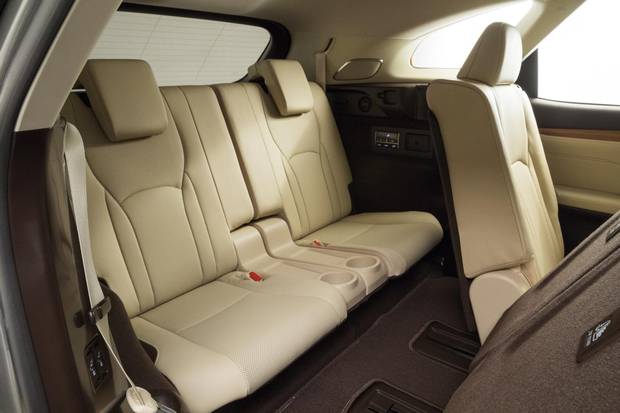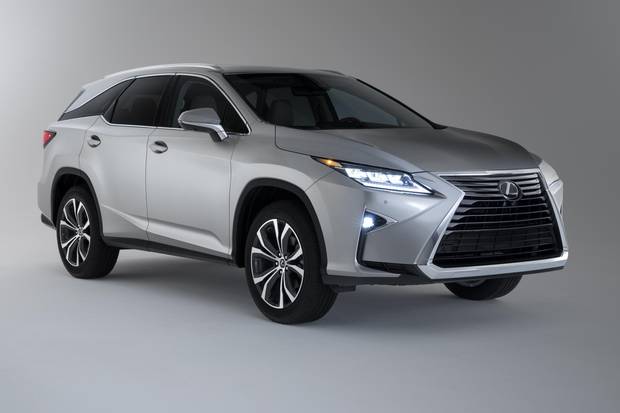A curious thing happened during the Lexus show-and-tell at the Los Angeles Auto Show, back in November.
First, Lexus U.S. executive Jeff Bracken pulled the wraps off the RX 350L – a new version of the mid-size SUV distinguished by a third row of seats. Then, he announced a new version of the larger LX SUV, which doesn't have a third-row seat. Consider the latter to be the exception to a developing trend.
As families bail out of sedans and minivans and into SUVs and CUVs, the industry is offering a growing variety with third-row seats. Subaru's new Ascent and a concept "teaser" of BMW's X7 were also displayed in L.A. as forthcoming seven-seaters. There are now more than 20 SUVs with available three-row seating, including the Toyota Highlander, Chevrolet Tahoe, Buick Enclave, Ford Expedition, Mazda CX-9 and Mitsubishi Outlander.
BMW X7.
BMW
The auto makers are finding ways to make access easier. The Land Rover Discovery, for instance, allows users to configure the second and third rows electronically by using a switch located in the cargo area, the dashboard touch screen or your smartphone.
Count on three-row SUVs being prominently displayed at the North American International Auto Show in Detroit next week.
"Volumes are up for utilities across the board," says John Bardwell, subject-matter expert for Bond Brand Loyalty, "but an interesting trend is medium [read: two-row] utilities giving up share to large [read: three-row] utilities."
The debuts in Los Angeles followed Volkswagen's launch last summer of its three-row Atlas, which is selling at about five times the pace of its two-row Touareg predecessor. As well, VW added a third-row option on the 2018 compact Tiguan, which is also dramatically outselling its smaller two-row predecessor.
2018 VW Atlas.
Andrew Trahan Photography LLC
Ford Explorer three-row sales were up 14 per cent through November while sales of the Edge, its two-row sister vehicle, had dipped 2 per cent.
You won't find any obvious explanation for this trend in basic demographics. Paradoxically, the trend toward more-seat CUVs parallels shrinking household sizes and growing numbers of single- or two-person households.
A few years ago, a Chevrolet executive told us only 35 per cent of Tahoe buyers have children at home, and only 22 per cent have more than one child; respective numbers for Tahoe's bigger Suburban sibling are still only 55 per cent and 49 per cent (both SUVs are three-rows).
Arguably, minivan sales have been affected most by changing demographics. In 2001, Canadians bought more than 200,000 of them, accounting for one in seven of all vehicles sold. By 2016, their sales had plunged to fewer than 100,000 – just one in 20 of all sales.
Minivans still make far more sense than SUVs for those truly needing comfortable, accessible and versatile space for multiple passengers and/or their stuff. But minivans are uncool, SUVs are sexy, and with a three-row SUV, at least you have options.
Lexus Canada chief Jennifer Barron cites her neighbour, who wants a three-row vehicle, "not that he needs it every day, but for the occasion when the parents are in the car, or when they are the ones picking up all the kids to take them to soccer. So they are looking for that versatility."

Interior of the 2018 Lexus RX 350L.
JAMES HALFACRE/LEXUS
Paul McCallum of Bond Brand Loyalty notes that a strong economy, coupled with the improved fuel efficiency of mid-size, seven-seat SUVs, encourages buyers to go big.
"I think of it as an if/then scenario. 'I want an SUV, I won't need to offset size for efficiency, the market is rife with options, and although I don't need to carry seven passengers today, if I do in the future then I will have it, just like that second spare room."
2017 Nissan Rogue.
Nissan
There are even three-row compact CUVs – but not many, and historically few buyers choose them. The last-generation Toyota RAV4 offered a third-row option, but it was dropped for the 2014 redesign (in 2012, only 2.2 per cent of RAV4 buyers chose it). Nissan introduced it on the 2014 Rogue, but it goes away in 2018. It is offered on only one of seven RAV4 trim grades. Nissan also confines it to one trim, and then only in combination with the Moonroof and Technology package for $3,550 total.
That leaves the VW Tiguan and the Mitsubishi Outlander as the remaining three-row compacts. At least they should have staying power: On the Tiguan, it's a $750 stand-alone option on all three trim grades; on the Outlander, it's optional on one and standard on three of the five trims.
2018 Mitsubishi Outlander.
Mitsubishi
So far, about one-third of Tiguan buyers are taking the third-row option.
As for the larger SUVs, where most of the action is, "It would seem that 50 per cent more rows for 10 per cent more outlay is generating a lot of the movement," Bardwell says. "Even if I don't need the extra seats, keeping them folded will give me a significant increase in cargo volume [to say nothing of bragging rights and perceived status/prestige]."
As for the two-row LX, more than in most SUVs, the third-row steals space in the LX even when folded,and Bracken explained that some owners asked for more cargo space. "Those who are empty-nesters or have lots of gear to haul tell us they don't always need the third row."
SUV options for a variety of sizes and styles
Compact
Mitsubishi Outlander
From $26,698
Mitsubishi
The dark horse of compact SUVs, the Outlander has a third row optional on one of its five trims and standard on three (including the Anniversary Edition). It's also one of the few compacts with an available V6 engine; and a segment-exclusive plug-in hybrid version is coming soon. The latter, however, will be two-row only – the batteries have to go somewhere.
Mid-size
From $32,199
steve petrovich
Built in Canada, Ford's polarizing take on a utility doesn't look like an SUV, but it's not a minivan either. However, its ample legroom in all three rows is minivan-like, ditto how its third-row seat folds down into a deep well, which means bonus cargo room. AWD is optional with the base 287-horsepower, 3.5-litre V-6 and standard with the 365-hp EcoBoost version.
Large
From $59,850
Paul Giamou
Toyota's "traditional large" (as the industry calls them) SUV is physically among the category's smaller offerings, but claims cargo and passenger space that compare well with the hardest-to-park behemoths. Three trim grades are all powered by the same 381-horsepower hp, 5.7-L V-8. The tow rating of 7,100 pounds is bettered by most rivals.
Luxury
From $68,500
BMW's "Sport Activity Vehicle" (as only BMW calls it) is closer in size to typical mid-size, two-row, luxury SUVs, but it does manage to squeeze in a third row as a stand-alone option on all versions except the plug-in hybrid. Engine choices include inline 3.0-L six-cylinder or diesel engines, or a 4.4-L, gasoline V-8, all turbocharged.
Shopping for a new car? Check out the new Globe Drive Build and Price Tool to see the latest discounts, rebates and rates on new cars, trucks and SUVs. Click here to get your price.
